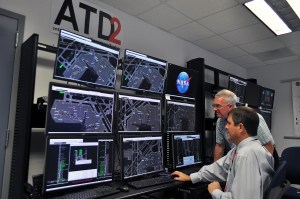
Entrepreneurs dream of finding a million-dollar idea; NASA Armstrong Flight Research Center has several such ideas just waiting to be tapped.
NASA Armstrong has a variety of technologies available for U.S. businesses and universities to license, including a wireless hub to make updating vehicle electronics and sensors easier, and the Fiber Optics Sensing System (FOSS) that can take thousands of measurements along a fiber optic wire about the thickness of a human hair.
It’s the mission of NASA Armstrong’s Technology Transfer Office (TTO) to connect businesses, universities, and other government agencies with technologies developed by the center.
“The idea is to get that technology out into the general public for all of us to enjoy the fruits of NASA’s labor,” said Benjamin Tomlinson, NASA Armstrong’s Technology Transfer Officer. “We want American businesses to be able to take these technologies that we’ve developed in-house and make them publicly available.”
To determine how NASA prioritizes which technologies they’ve developed will get matched with outside organizations, TTO uses an evaluation process.
“The technology gets evaluated to determine what kind of market is out there for it and if it’s patentable. Our technology must be protected with a patent,” Tomlinson said. “After our internal Armstrong evaluation, we send the technology to the agency evaluation process. If they agree we have a technology that needs protection, they will recommend and provide us a market assessment. If the technology has commercial opportunities, we proceed to patent.”
TTO then tries to match technologies with prospective users through professional and academic organizations geared toward that field, technology reviews, and webinars.
Those interested in licensing NASA technology can access the agency’s technology transfer site https://technology.nasa.gov, which shows everything the agency has patented. If a technology interests them, the website will show the NASA center that owns that patent as a contact.
“Sometimes the technology isn’t really detailed in a patent, so they’ll need one of our people within the Technology Transfer Office to explain it to them,” Tomlinson said. “If they need even more in-depth information, we’ll set up meetings with the inventors and have them explain it in a lot more detail.”
When an outside organization enters into a licensing agreement to use a NASA technology, the agency gets a percentage of the sale. Some of the funds collected go to the inventor and the inventor group and some goes to the center where the technology came from. NASA Armstrong has used the funds to pay for new equipment and training.
There are also times that a NASA Armstrong technology is interesting to an industry, but it needs a bit more advancement for their needs, Tomlinson said. “We are trying to bridge the gap by trying to develop it further than what we have right now,” Tomlinson said. “That would make it a lot more attractive to a commercial company to be able to take it and run with it.”
One such example is a wireless hub that can serve as a gateway between an aircraft’s sensors and its displays or data collection systems. The hub serves as an information control point, receiving data wirelessly from a sensor and then passing the data on to an aircraft display.
The hub, or gateway, can be reprogrammed so a new wireless sensor system could be installed without having to install heavy cabling and wiring.
The technology generated interest, including from a major airline, but the feeling was that it wasn’t developed to a point where it was easy for them to “plug and play,” Tomlinson said. TTO is working on a flight test program to advance the technology.
Commercial users licensing NASA Armstrong technology are often small companies, Tomlinson said.
“We want to get the small businesses to take these technologies we’ve developed in-house and make them publicly available,” Tomlinson said.




























